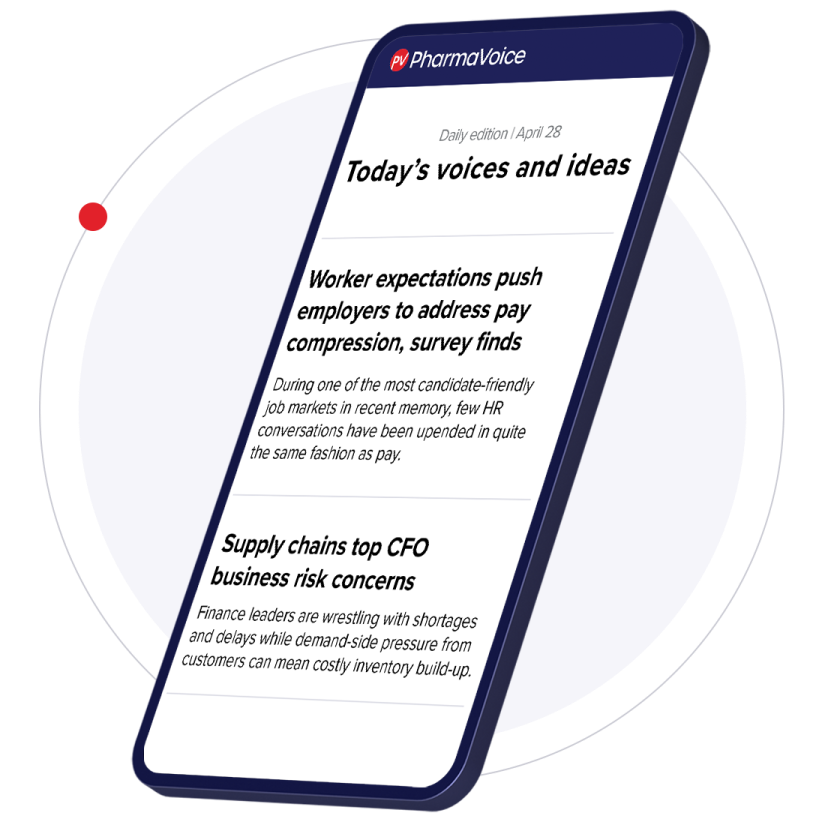This is the second installment of a two-part series previewing pharma’s year ahead. Our first part examines how industry leaders see the financial market taking shape in 2024.
It’s an exciting time to be in the business of drug innovation.
The recent arrival of the world’s first approved CRISPR-based therapy has helped solidify the gene therapy movement and pave the way for more gene editing approaches. Other cutting-edge modalities such as cell therapies, antibody-drug conjugates and a new wave of RNA-based treatments are offering drug developers transformative tools for bringing more effective treatments — and even cures — to some of the world’s toughest diseases and conditions.
The continuing rise of the patient voice and emphasis on DEI are also poised to help the industry create impactful medicines in the coming years.
And as innovations around AI, data analysis and machine learning become more deeply embedded in these efforts, drug discovery and development is reaching groundbreaking levels of speed and efficiency.
It’s no surprise that when we asked industry leaders to submit their outlooks for 2024, these themes were a common thread. Here’s how they see these trends translating into meaningful industry change in 2024.
Trends in drug innovation
More antibodies will come to market

“The growth of new modalities such as antibody-drug conjugates, bispecific antibodies, and cell and gene therapies, are already making a larger presence in the investigational pipeline. The focus on these novel therapies indicates a move towards addressing previously difficult-to-treat diseases, including advanced cancer and rare diseases. With hundreds of antibodies undergoing pre-clinical and clinical development, it is anticipated that the number of antibody medications in clinical trials and approved by regulatory agencies will rise.”
Tahi Ahmadi, executive vice president, chief medical officer, head of experimental medicines, Genmab
Cell and gene therapy development will become more streamlined

“With over 500 new cell and gene therapies entering clinical trials annually [and] their expedited time to market … this class of therapeutics [is positioned] for significant prominence. As we approach 2024, the prospect of witnessing a surge in approvals becomes increasingly imminent. Concurrently, the FDA's proactive initiatives to bolster the advancement of these therapies promise to usher in a new era of standardization. Expectations include the streamlining of manufacturing processes, consolidation of protocols for testing Critical Quality Attributes, refined approaches to patient identification and enrolment and the evolution of companion diagnostics.”
Michelle Fraser, head, cell and gene therapy, Revvity
Delivery tech will push gene therapy into new space

"The gene therapy environment has evolved rapidly and we are now seeing expansion into novel therapeutic areas like cardiovascular diseases, such as cardiomyopathies with genetic markers of disease. Innovation in delivery technology will continue to enable this shift, particularly AAV technology given the high transduction efficiency in cardiomyocytes, but we also predict advancement of novel delivery systems. At the same time, there has been a material shift in the regulatory landscape for both gene therapy and cardiovascular disease, with precedents now utilizing biomarkers as pivotal study endpoints as opposed to historical standards related to mortality and survival.”
R. Nolan Townsend, CEO, Lexeo Therapeutics
R&D will target the underlying causes of aging

“Aging is the one health condition that has a prevalence rate of 100%. As a result, we are going to see more interest in how to address the underlying causes of aging to preserve vitality, mobility and physical appearance. This will lead to next-generation research and treatments that incorporate the underlying causes of aging versus merely addressing the signs and symptoms of the aging process to support health and longevity.”
Carrie Strom, senior vice president, AbbVie; president, Global Allergan Aesthetics
Next-generation mRNA is coming

“As we move forward into 2024, we anticipate a continued focus on innovation in vaccines and with that, an interest in some of the newly emerging technologies such as self-amplifying mRNA (sa-mRNA). There is an ever-present need for flexible, effective vaccine technology and as demonstrated during the COVID-19 pandemic, mRNA technology can facilitate rapid and scalable vaccine development and distribution. The sa-mRNA technology adds to these benefits by offering the potential for stronger immune responses and longer duration of protection, while using significantly lower doses compared to conventional mRNA vaccines.”
Stefan Merlo, vice president, commercial development, CSL Seqirus
The obesity space will quickly evolve

“Obesity is the primary driver of metabolic diseases and, in 2024, will still account for more morbidity and mortality than all cancers combined. In 2024, we will continue to see the expansion of GLP-1 and other incretin-based approaches as the broader obesity market continues to grow. As we think about next generation approaches to treating metabolic diseases, there is a need to focus on molecular targets with new and alternate mechanisms, including those that work by safely increasing the metabolic rate. I also anticipate that machine learning and AI will play a critical role in the field, including in identifying new small molecules in a faster and more efficient way.”
Dr. Jayson Dallas, CEO, Rivus Pharmaceuticals
AMR investments will tick up

“We predict a return to investment in antivirals and antibiotics to address current and future medical needs. COVID-19, the flu and RSV aren't going away and the chance of getting sick with even one of these viruses is high. We need to start actively addressing the largely silent threat of antimicrobial resistance, which could cause up to 10 million deaths by 2050 according to the United Nations. New viral threats could emerge at any time, leading to future pandemics.”
Margaret Borys, senior vice president, chief commercial officer, Shionogi
More R&D will incorporate patient voices

“In 2024, I expect our work in early research to be even more patient-centric. It’s vital for those who research and develop medicines to listen to and engage with people impacted by severe diseases, and go further by deep investigation into the pathways driving their disease using relevant disease models. We must meaningfully consider their lived experiences in the earliest stages of R&D to ensure we are developing medicines [that] positively change the way people are living with severe disease and focus on addressing the root biological causes of these conditions; these go hand in hand. This means connecting our research teams with people and their caregivers living with the conditions we’re researching.”
Roger Palframan, head of U.S. research, UCB
Maternal health innovation will gain steam

“The maternal health crisis continues to pose serious risks for moms-to-be across the U.S. This unfortunate reality is particularly dangerous for Black women, who are three times more likely than white women to die from pregnancy-related complications. New initiatives inspire hope that 2024 will mark a turning point. For instance, innovations are coming to the fore … like the creation of an artificial womb, which the FDA is exploring as a potential approach to help premature babies survive. The White House’s ‘Birthing Friendly’ Hospitals Initiative is [also] an important step towards helping women find high-quality maternal care. And … the WHO is working alongside key public and private stakeholders on a solutions-driven, strategic roadmap to … improve maternal health outcomes. These developments create positive momentum … to address critical gaps in maternal health.”
Colby Holtshouse, global medtech commercial lead, Organon
Cancer care advances
More emphasis in oncology will be on early detection

“We know that the earlier we can detect and address cancer, the closer we may be to better outcomes. In the new year, I expect we’ll see a continued shift to earlier detection and intervention, both through improved access to cancer screenings and beginning treatment sooner in one’s cancer journey, as well as a supportive infrastructure that enables patient access to innovation and resources.”
Mohit Manrao, senior vice president, head, U.S. oncology, AstraZeneca
Successful oncology launches will be driven by tech

“Digital and technological advancements will continue to accelerate in 2024. It will be up to us to responsibly leverage these tools to meet the needs of patients and providers more effectively. This will be particularly crucial for oncology companies to advance innovative R&D and optimize the delivery and use of new medicines. I predict the success of future product launches will be partially measured by the ability of developers to integrate digital processes into every step of delivering care — helping us solve potential challenges that may arise, increasing accessibility to a variety of patient populations, and eliminating barriers to care.”
Stefanie Granado, head, U.S. oncology business unit, Takeda Oncology
Strides will be made with tough-to-treat cancers

“The industry is gearing up to address the persistent challenges of hard-to-treat and treatment-resistant cancers. For example, although PD(L)-1 inhibitors have demonstrated effectiveness for numerous NSCLC cases, certain forms of NSCLC don't respond. In addition, resistance develops in patients who initially respond to certain therapies. To address this, companies are directing efforts toward these challenging forms of the disease, striving to provide better outcomes for all patients. With an emphasis on cutting-edge technology platforms and robust drug development portfolios, the sector is poised for substantial progress in 2024. The integration of sound mechanistic and scientific rationale in clinical trials, exploring both monotherapy and combination approaches, reflects a significant leap toward conquering difficult cancer types.”
Guo-Liang Yu, CEO, chairman, Apollomics
The tech effect
The data analyst role will evolve

“As more AI-based solutions are embedded into our workflows in 2024, it will fundamentally change the role of the data analyst. We have already seen the beginnings of an evolution from data management to data science, but fundamental questions remain. Next year, we expect the discussion to focus on how analysts can learn and progress when entry-level work and data sorting is performed by a machine, how to strike the appropriate balance between AI and human insights, and how to communicate algorithm-based decisions to various research stakeholders.”
Graham Clark, CEO, Phastar
Generative AI will transform healthcare

“We’ve been talking about AI for some time, and 2024 will be the year that testing and unleashing generative AI will create value in healthcare to enable patients to live their best lives in ways that work for them individually. Based on a well-thought-out and executed overall data strategy, data-powered and data-providing initiatives will continuously inform the individualized next step for each eligible patient. The power of predictive algorithms will coordinate personalized care, from diagnosis to treatment, to find the right resources, technology and solutions at the right time. With data, we can finely tune our knowledge of patients’ individual journeys, zeroing in on their specific needs.”
Kim Moran, senior vice president, head, U.S. rare diseases, UCB
Regulatory shifts
The biomarker push will remain strong

"We have seen an industrywide push for the FDA to provide additional guidance and support to advance gene therapies for rare and ultra-rare diseases, and this will remain a constant theme in the upcoming year. There is a clear appetite from agency leadership, but we need to see this reflected in the review divisions with more consistency. Bipartisan support from Congress has empowered the agency to adapt its policies to keep pace with innovation, but in order to effect change the agency needs to shift to a nimbler approach and place the people living with degenerative rare diseases at the crux of decision-making. In 2024, the industry needs — and patients deserve — guidance on qualifying biomarkers to support the accelerated approval pathway for rare and ultrarare diseases with limited or no treatment options."
Dr. Emil Kakkis, CEO, Ultragenyx Pharmaceutical
The drug discount system will need a reboot

“The drug discount market will continue to see unprecedented growth in 2024 from the 340B program and Medicaid Drug Rebate Program, along with commercial rebates. This raises questions about the ability of drug discount stakeholders, such as drug manufacturers, covered entities, and state Medicaid agencies to handle that extra volume. We’re at the point where the entire drug discount system needs to be redesigned or it will collapse under the weight of its own complexity and lack of coordination. Next year we can expect drug manufacturers to push for changes that will mitigate the impact of regulatory control and program complexity while helping to reduce revenue bleed from duplicate discounts, which result in higher drug prices for consumers.”
Angie Franks, CEO, Kalderos
Clinical trial transformations
DEI will drive innovation

“As we approach 2024, the landscape of diversity, equity, and inclusion in clinical trials is on the brink of a transformative shift, and I envision a future where DEI is not a mere checkbox but a catalyst for groundbreaking advancements in medical research. The industry is moving toward a collective commitment that aims to dismantle historical barriers and address social determinants of health, acknowledging and rectifying the health disparities experienced by people from marginalized groups. Through these intentional efforts, the industry can anticipate more robust and reliable research outcomes that are not only equitable and inclusive but ultimately more impactful for all.”
Adrelia Allen, executive director, clinical trial patient diversity, Merck & Co.
Patients will inform trial design
“2024 will be the year of patient-driven trial design. We are already seeing the adoption of new solutions integrating multiple, study-specific efficacy and safety criteria into a single aggregated measure. This will estimate the net benefit of treatments which will help improve the clinical pertinence of trials and can minimize their sample size — on average by 20%.”
Marc Buyse, founder, International Drug Development Institute
Removing financial barriers to research will become a priority

“Next year, we hope to see a heightened focus in the industry on removing financial barriers to clinical trial participation — barriers that disproportionately affect people from lower socioeconomic and minority groups and result in a lack of diversity that threatens the efficacy of the drug development process. Clinical trial payments should be tax free, participants should have a choice in how they receive their funds and monthly inactivity fees must become a thing of the past.”
Sam Whitaker, co-CEO, co-founder and Jason Dong, co-CEO, co-founder, Mural Health
A new phrase will shape clinical trials

“’Patient-mediated research’ will be the buzzword of 2024. With decentralized clinical trials (DCT) and increased ability to leverage insights from real-world data sources such as electronic health records (EHR) from hospitals and patient-reported outcomes (PROs), drug developers now have a direct line to the patients they seek to serve. By utilizing this connection and working closely with patient advocacy groups and innovative tools built by patients with lived experience, they have an opportunity to set up and conduct trials faster and collect richer data.”
Vincent Keunen, CEO, founder, Andaman7
DCTs will become standard

“The acronym ‘DCT’ will die away as decentralization becomes the norm. As noted by the FDA, the modernization of clinical trials is an ongoing evolution. In the U.S., it will require an act of Congress to change the definition because the term DCT is used in provisions published by the Food and Drug Omnibus Reform Act of 2022 (FDORA) that amended the Federal Food, Drug, and Cosmetic Act and the Public Health Service Act. Even with existing regulatory nomenclature, the acronym DCT will become less of a call-out as a distinct type of unique clinical trial — and that is a step in the right direction. By this time next year, decentralized clinical trials will simply be clinical trials (with certain parts appropriately decentralized) and the impact of this model will be much more prevalent.”
Dr. Pamela Tenaerts, chief scientific officer, Medable
Informed consent will become easier

“Next year, we’ll see renewed, cross-industry focus on informed consent frameworks for clinical research study participants — with a particular focus on transparency, trust and explaining how different sources of data are used for research. Instead of long consent forms that patients skip over, we’ll begin to see consent broken down into smaller steps, so patients can decide what they give permission for, for example, permission to recontact, or to link their data from different sources. The technical ability to capture these permissions in metadata will become an important part of data stewardship.”
Amy Abernethy, president, product development; chief medical officer, Verily
Talent will stay competitive

“In 2024, as the clinical research industry explores options to speed up its development pipelines and decrease cost, many will be looking to further migrate toward functional service provider (FSP) outsourcing models, in both the traditional and hybrid approaches. As such, we expect the sourcing of clinical development talent for client engagements to remain highly competitive. To help address this situation, large CROs that provide both full-service outsourcing (FSO) and FSP solutions … will be best positioned to deliver traditional FSP talent deployment.”
Les Enterline, senior vice president, FSP therapeutic unit head, PPD clinical research business, Thermo Fisher Scientific
Two key strategies will help diversify trials

"In 2024 and beyond, clinical trials will see a renewed commitment towards more structured inclusivity and equity in trial recruitment, diversifying based on race and location (urban vs. rural). Expect a dual strategy to accomplish this: AI for rapid patient population identification and a community-centric approach to address historical fears and mistrust in certain communities towards clinical trials."
Ramita Tandon, chief clinical trials officer, Walgreens
Trials will feel the need for speed

“The pharmaceutical marketplace is more competitive than ever, particularly in the race to be first-to-market. The first-mover advantage is dramatic, so clinical trial sponsors are hyper-focused on making sure they are maximizing every second. To that end, large pharmaceutical companies are setting lofty goals of 50% reductions in cycle time next year — meaning, the status quo won’t allow them to reach significant new goals. Sponsors will need to make commensurate changes to accelerate drug development. DCT methodologies will be part of [that] standard toolkit.”
Alison Holland, executive general manager, customer value, Medable
Better data analysis will be a side effect of DCTs

“Health Economics Outcomes Research (HEOR) will become more common in DCTs. This year we saw the maturation of Claims and Health Information Exchanges, which enable a cost-effective and straightforward process for researchers to gain access to identified patients’ data. Given the improvements in costs, trial sponsors can now take advantage of these exchanges at scale and leverage the data for both pre-screening and health economic analysis. As DCTs and virtual site acceptance accelerates, a knock-on effect will be that more of these trials will include HEOR analysis.”
Joel Morse, CEO, co-founder, Curavit Clinical Research


















